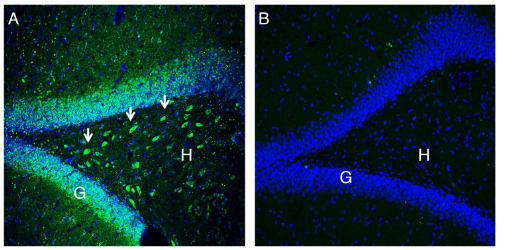Overview
- Peptide (C)KDNGELPN DERFSVD, corresponding to amino acid residues 583-597 of rat NrCAM (Accession P97686). Extracellular, N-terminus.

 Western blot analysis of rat brain (lanes 1 and 5), mouse brain (lanes 2 and 6), rat cerebellum (lanes 3 and 7) and human SH-SY5Y neuroblastoma cell (lanes 4 and 8) lysates:1-4. Anti-NrCAM (extracellular) Antibody (#ANR-045), (1:200).
Western blot analysis of rat brain (lanes 1 and 5), mouse brain (lanes 2 and 6), rat cerebellum (lanes 3 and 7) and human SH-SY5Y neuroblastoma cell (lanes 4 and 8) lysates:1-4. Anti-NrCAM (extracellular) Antibody (#ANR-045), (1:200).
5-8. Anti-NrCAM (extracellular) Antibody, preincubated with NrCAM (extracellular) Blocking Peptide (#BLP-NR045).
 Expression of NrCAM in rat hippocampus.Immunohistochemical staining of perfusion-fixed frozen rat brain sections with Anti-NrCAM (extracellular) Antibody (#ANR-045), (1:200), followed by goat anti-rabbit-AlexaFluor-488. A. Staining in the rat hippocampal dentate gyrus region, showed immunoreactivity (green) in neurons of the hilus (H, arrows). B. Pre-incubation of the antibody with NrCAM (extracellular) Blocking Peptide (BLP-NR045), suppressed staining. Cell nuclei are stained with DAPI (blue). G = granule layer.
Expression of NrCAM in rat hippocampus.Immunohistochemical staining of perfusion-fixed frozen rat brain sections with Anti-NrCAM (extracellular) Antibody (#ANR-045), (1:200), followed by goat anti-rabbit-AlexaFluor-488. A. Staining in the rat hippocampal dentate gyrus region, showed immunoreactivity (green) in neurons of the hilus (H, arrows). B. Pre-incubation of the antibody with NrCAM (extracellular) Blocking Peptide (BLP-NR045), suppressed staining. Cell nuclei are stained with DAPI (blue). G = granule layer.
- Mohan, V. et al. (2019) Front. Cell Dev. Biol. 7, 9.
- Brummer, T. et al. (2019) EMBO Mol. Med. 11, 4.
- Demyanenko, G.P. et al. (2014) J. Neurosci. 34, 11274.
NrCAM (Neuron-glia related cell adhesion molecule) is a cell adhesion molecule that belongs to the immunoglobulin-class (Ig) of the L1 family. NrCAM promotes axon growth and repulsion through trans homophilic binding of extracellular domains and intracellular coupling of the conserved cytoplasmic domains to the actin cytoskeleton. This interaction occurs through ankyrin B and ezrin-radixin-moesin adaptors. In addition, NrCAM is responsible for controlling dendritic spine densities, axonal guidance and targeting, and neurite outgrowth by acting as a co‐receptor molecule at the neuronal cell surface1,2.
NrCAM is highly expressed in the cortex1,3. Its structure contains a PDZ binding motif with the potential to bind PSD scaffold proteins PSD-95 and SAP102. The Ig domains of the protein mediate homophilic and heterophilic binding to multiple ligands2,3.
Genetic polymorphisms in the NrCAM gene are linked to autism spectrum disorders, intellectual disability and addictive behavior. NrCAM knockout mice demonstrate autism spectrum disorder related behaviors including impaired sociability, cognitive inflexibility, hypersensitivity to sensory stimuli and altered visual cortical responses.
Application key:
Species reactivity key:
Anti-NrCAM (extracellular) Antibody (#ANR-045) is a highly specific antibody directed against an extracellular epitope of the rat protein. The antibody can be used in western blot analysis, immunohistochemistry and flow cytometry applications. It has been designed to recognize NrCAM from human, rat and mouse samples.

